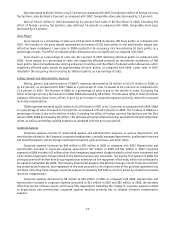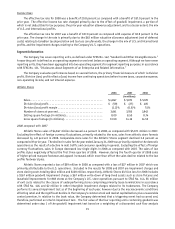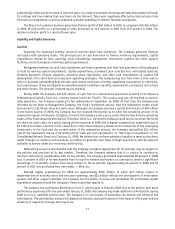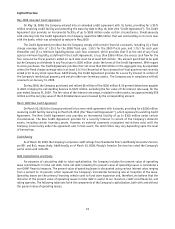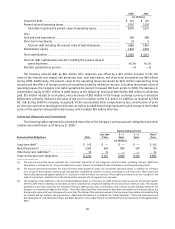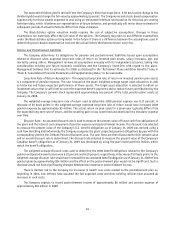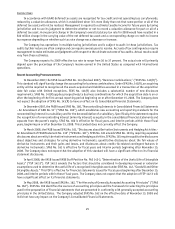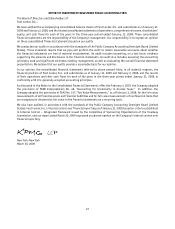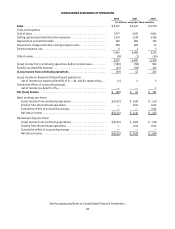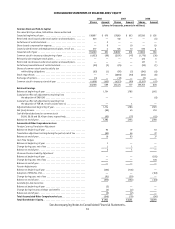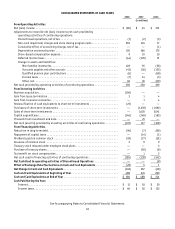Foot Locker 2008 Annual Report Download - page 38
Download and view the complete annual report
Please find page 38 of the 2008 Foot Locker annual report below. You can navigate through the pages in the report by either clicking on the pages listed below, or by using the keyword search tool below to find specific information within the annual report.
22
Significant judgment is required for these estimates and assumptions, as well as to differentiate between
promotional and other markdowns that may be required to correctly reflect merchandise inventories at the lower of
cost or market. The Company provides reserves based on current selling prices when the inventory has not been marked
down to market. The failure to take permanent markdowns on a timely basis may result in an overstatement of cost under
the retail inventory method. The decision to take permanent markdowns includes many factors, including the current
environment, inventory levels and the age of the item. Management believes this method and its related assumptions,
which have been consistently applied, to be reasonable.
Vendor Reimbursements
In the normal course of business, the Company receives allowances from its vendors for markdowns taken.
Vendor allowances are recognized as a reduction in cost of sales in the period in which the markdowns are taken.
Vendor allowances contributed 30 basis points to the 2008 gross margin rate. The Company also has volume-related
agreements with certain vendors, under which it receives rebates based on fixed percentages of cost purchases. These
volume-related rebates are recorded in cost of sales when the product is sold and they contributed 10 basis points to
the 2008 gross margin rate.
The Company receives support from some of its vendors in the form of reimbursements for cooperative
advertising and catalog costs for the launch and promotion of certain products. The reimbursements are agreed upon
with vendors for specific advertising campaigns and catalogs. Cooperative income, to the extent that it reimburses
specific, incremental and identifiable costs incurred to date, is recorded in SG&A in the same period as the associated
expenses are incurred. Reimbursements received that are in excess of specific, incremental and identifiable costs
incurred to date are recognized as a reduction to the cost of merchandise and are reflected in cost of sales as the
merchandise is sold. Cooperative reimbursements amounted to approximately 38 percent of total advertising costs in
2008 and approximately 12 percent of catalog costs in 2008.
Impairment of Long-Lived Assets, Goodwill and Other Intangibles
In accordance with SFAS No. 144, “Accounting for the Impairment or Disposal of Long-Lived Assets” (“SFAS
No. 144”), the Company recognizes an impairment loss when circumstances indicate that the carrying value of long-
lived tangible and intangible assets with finite lives may not be recoverable. Management’s policy in determining
whether an impairment indicator exists, a triggering event, comprises measurable operating performance criteria at
the division level as well as qualitative measures. If an analysis is necessitated by the occurrence of a triggering event,
the Company uses assumptions, which are predominately identified from the Company’s three-year strategic plans, in
determining the impairment amount. In the calculation of the fair value of long-lived assets, the Company compares
the carrying amount of the asset with the estimated future cash flows expected to result from the use of the asset.
If the carrying amount of the asset exceeds the estimated expected undiscounted future cash flows, the Company
measures the amount of the impairment by comparing the carrying amount of the asset with its estimated fair value.
The estimation of fair value is measured by discounting expected future cash flows at the Company’s weighted-average
cost of capital. Management believes its policy is reasonable and is consistently applied. Future expected cash flows
are based upon estimates that, if not achieved, may result in significantly different results. During 2008, the Company
recorded non-cash impairment charges totaling $67 million primarily to write-down long-lived assets such as store
fixtures and leasehold improvements for the Company’s U.S. store operations pursuant to SFAS No. 144.
In accordance with SFAS No. 142, “Goodwill and Other Intangible Assets,” the Company is required to perform
an impairment review of its goodwill and intangible assets with indefinite lives if impairment indicators arise and,
at a minimum, annually. The Company has chosen to perform this review at the beginning of each fiscal year, and it
is done in a two-step approach. The initial step requires that the carrying value of each reporting unit be compared
with its estimated fair value. The second step — to evaluate goodwill of a reporting unit for impairment — is only
required if the carrying value of that reporting unit exceeds its estimated fair value. The Company used a combination
of a discounted cash flow approach and market-based approach to determine the fair value of a reporting unit. The
determination of discounted cash flows of the reporting units and assets and liabilities within the reporting units
requires us to make significant estimates and assumptions. These estimates and assumptions primarily include, but
are not limited to, the discount rate, terminal growth rates, earnings before depreciation and amortization, and
capital expenditures forecasts. The market approach requires judgment and uses one or more methods to compare
the reporting unit with similar businesses, business ownership interests or securities that have been sold. Due to the
inherent uncertainty involved in making these estimates, actual results could differ from those estimates.



